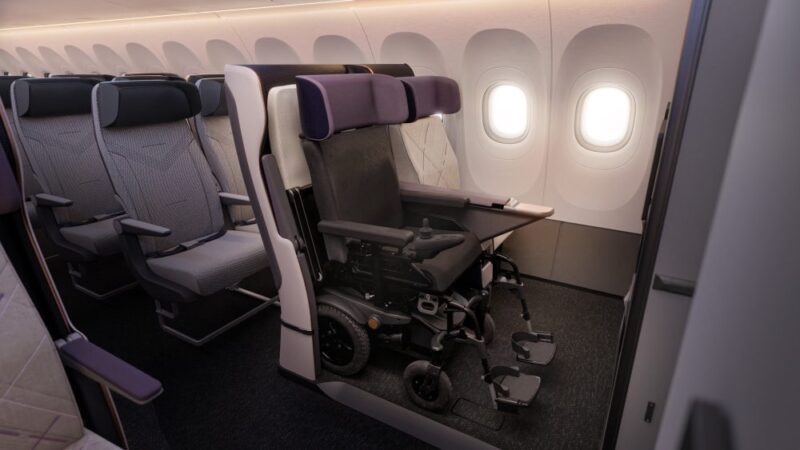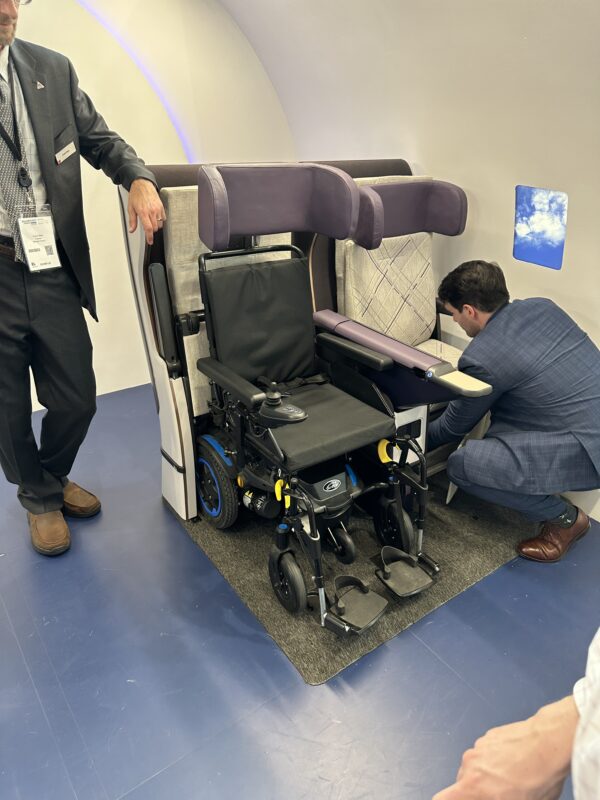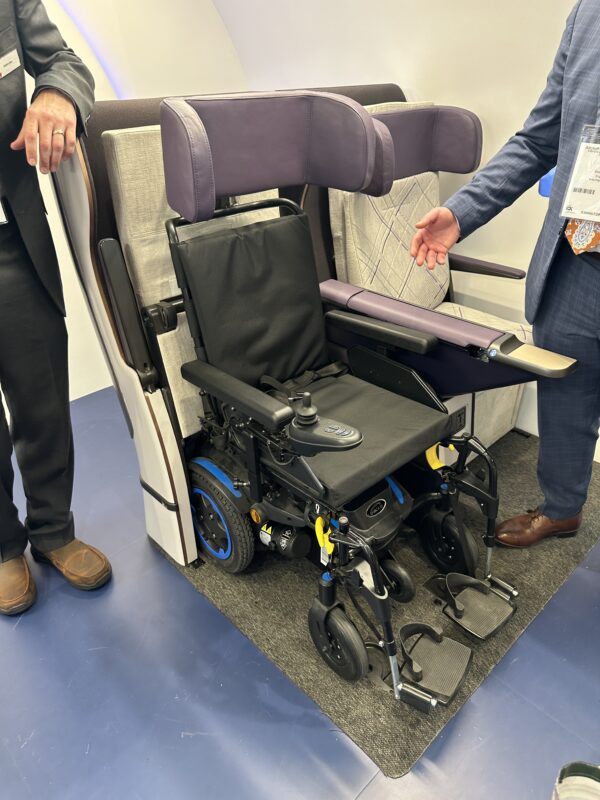We’re kicking off our post-AIX coverage with what I consider one of the most important innovations and demonstrations of Aircraft Interiors Expo 2023.
At Economy Class and Beyond, we’ve kept a close eye on the Air4All consortium and its work – the idea and development to allow a powered wheelchair to travel aboard an aircraft, without going into the cargo hold – with the risks of damage that could occur.
Well, just before Aircraft Interiors Expo, Delta Flight Products (a subsidiary of Delta Air Line), unveiled to the world a render of the design last week.

The idea is that it will allow customers who use a powered wheelchair to remain in their own wheelchairs for the entire journey. This is at no loss to the airline – where the seat converts from a standard passenger seat to an accommodation for wheelchair restraint.
The patented design offers comfort and safety for all passengers by providing access to headrests, centre console tray tables and a cocktail table that adjust to serve passengers with wheelchairs in place. The product also enables airlines to retain the design of their cabin on every seat.
But how does that work out in the real world?
Economy Class and Beyond got to look at the demonstrator at Aircraft Interiors Expo.
The design is targeted at the first row of a single-aisle aircraft in the initial phase – as that’s where there is the most room has a powered wheelchair manoeuvre in aircraft. Here we see the seat in its “two-passenger” configuration.

From here, it is a matter of having the seat converted from a normal domestic first seat into a bay for a powered wheelchair in several steps. The cushioning is removed and stored in the seat next to it. Once stored, the seat converts to reveal the anchor points and a place for a powered wheelchair to sit.
Here is a video of the process.
In the demonstration environment, it took around 1 minute 30 to convert the seat – indicating this could well be suitable for short turnarounds as needed by airlines.

The seat converted to accept a powered wheelchair.
The anchor points connect to the chair to provide a secure point for the chair to travel in flight, with the anchoring being done with retractable strapping.
The advantage
Disability travel in the air has been limited – let us be blunt. The innovations in this travel sector have been restricted to some brail, large format text and maybe some hairs to help non-powered chairs off and on the aircraft, whilst risking damage to powered chairs.
The risk to damaging powered chairs has been sadly well documented – bearing in mind most of these chairs are customised, and have extended lead times to replacement, depriving a passenger of their means of being able to move independently.
By bringing the powered chair into the cabin, where it can be restrained.
In Quotes
Rick Salanitri – President of Delta Flight Products said:
“DFP delivers highly engineered products and services to fill service gaps, solve operational challenges and transform the experience of customers and crewmembers,”
“Air4All is collaborating with DFP and our strong production and manufacturing capabilities to explore new ways to deliver equal access to comfort, safety, and dignity for all customers. This patented design offers new possibilities for customers with disabilities to enjoy a travel experience they truly deserve.”
Chris Wood, Founder of Flying Disabled added:
“An innovation like this in air travel provides those with reduced mobility a safe and comfortable way for them to travel and remain in their own power wheelchair,”
“It has taken truly a collaborative effort to develop this seat and we believe this product provides an optimal solution for all parties.”
The next steps

For passengers with reduced mobility – it’s going to be a game-changer seeing such a seat installed – with it lowering the risk of damage of their important mobility device. For the airlines, its a chance to put their money where their mouths are in terms of accessibility for all passengers.
There are many angles to look at this – from the publicity angle (because one headline about a powered wheelchair seat being destroyed is too many), to the cost of replacing the damaged seat, to reducing mishandling,
Of course – such a concept will need further work, with the seat will be sent for final design and validation. Testing and certification programs to install the seat will begin once certified.
Whilst there is no regulatory reason for these to be installed yet, PRM (Passengers with Reduced Mobility) legislation combined with FAA/EASA/UK CAA could force some sort of a solution like this to allow for any passenger to be carried.
We’ve seen many seats – but this is VERY different.
We see many seats at shows like this- but these are all variants of things that exist, and whilst there is some consideration for accessibility, where the passenger has some mobility.
Delta Flight Products with Air4All offers something very different – the ability for the passenger to remain in their seat, in a known environment.
Economy Class and Beyond will be closely monitoring what seems to be one of the most significant changes in airplane accessibility we’ve seen for a long time.
Kevin was a guest of Delta Flight Products for access to the stand (and demonstration), as well as Chris Wood of the Air4All consortium (representing PriestmanGoode, Flying Disabled, SWS Certification and Sunrise Medical).
Welcome to Economy Class and Beyond. Your no-nonsense guide to network news, honest reviews, in-depth coverage, unique research, as well as the humour and madness I only know how to deliver.
Follow me on Twitter at @EconomyBeyond for the latest updates, as well as Mastodon too! You can follow me on Instagram too!
Also, remember that we are part of the BoardingArea community, bringing you the latest frequent flyer news from around the world.
It’ll be interesting to see if these seats can be certified to the current requirements, which if I remember right is for the seat to not break free pulling 16G in a crash. Brilliant design, though, and power wheelchair users (and non-powered users for that matter) are very poorly accommodated on aircraft.
With the certification run due to start after the show, no doubt there will be challenges – although the team were pretty confident they could overcome this.
And yes – wheelchair travellers are very much underserved – either having to be shoved onto manual chair that is poorly designed for them, having ground delays – and at worse – having their chairs damaged beyond repair due to poor handling.
This will address a lot of problems in one fell swoop.